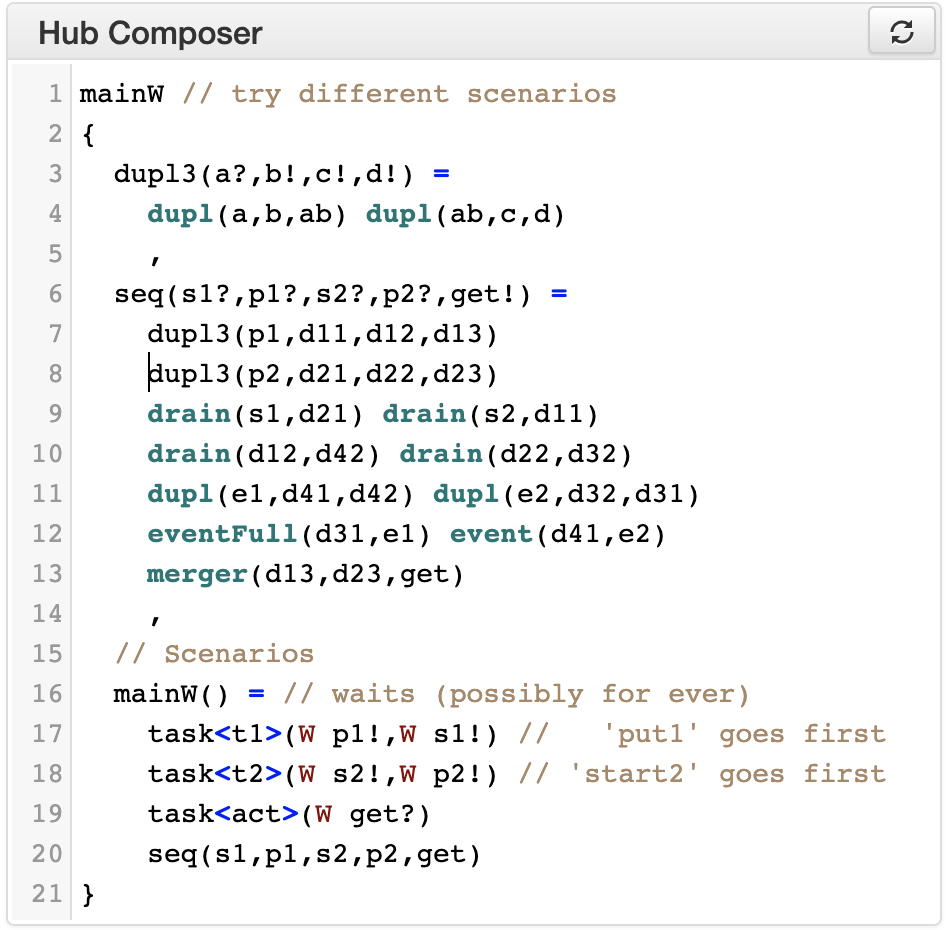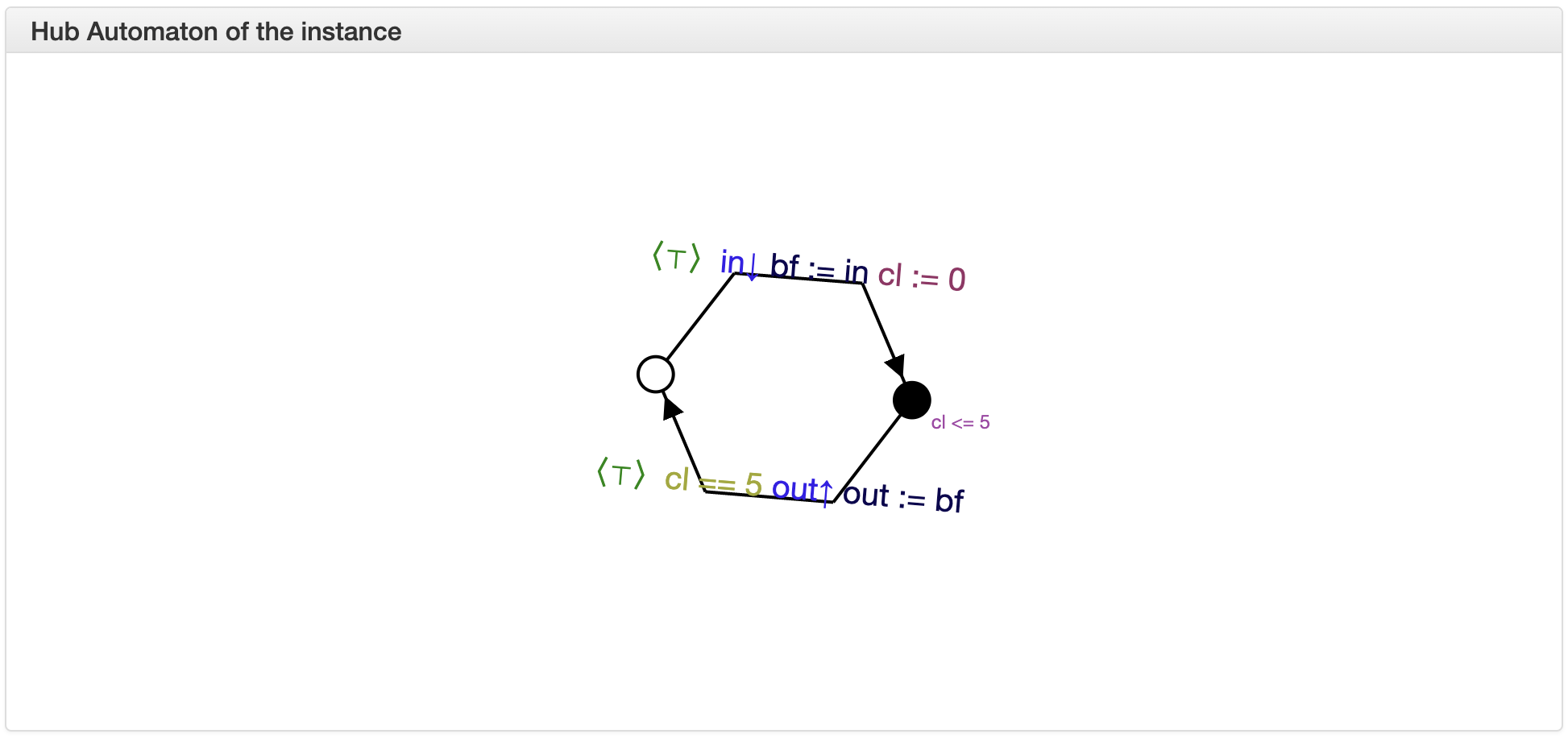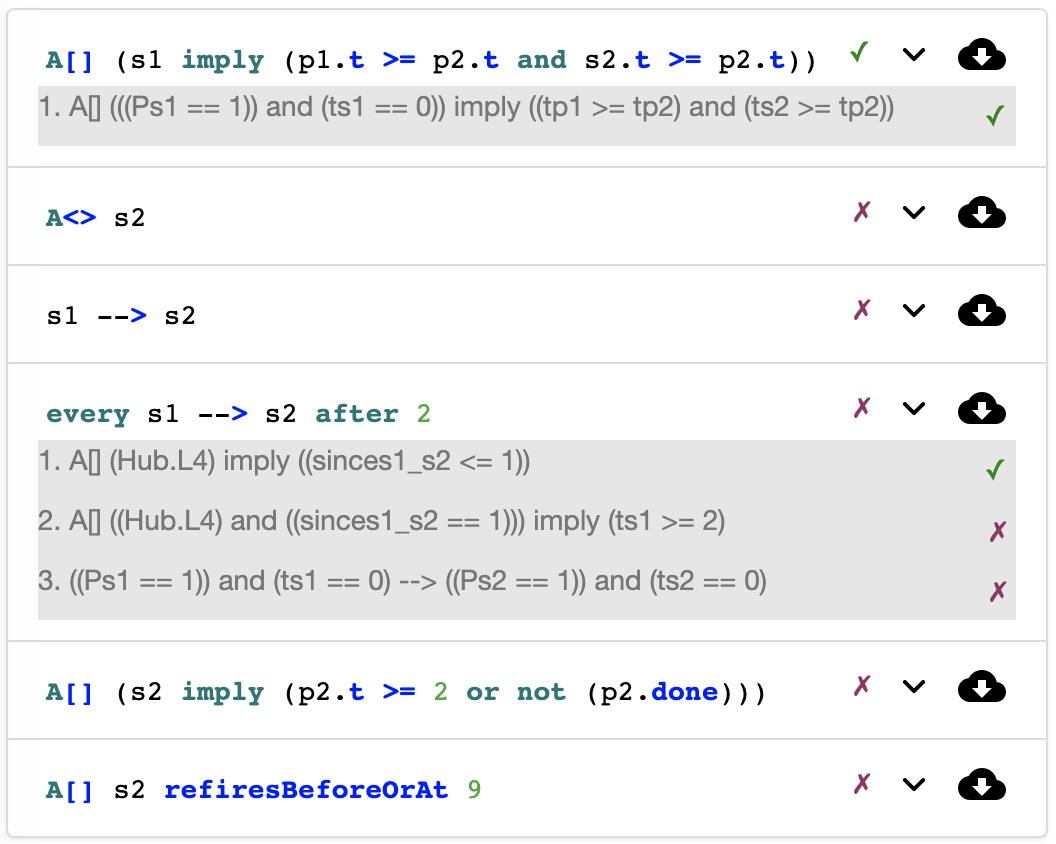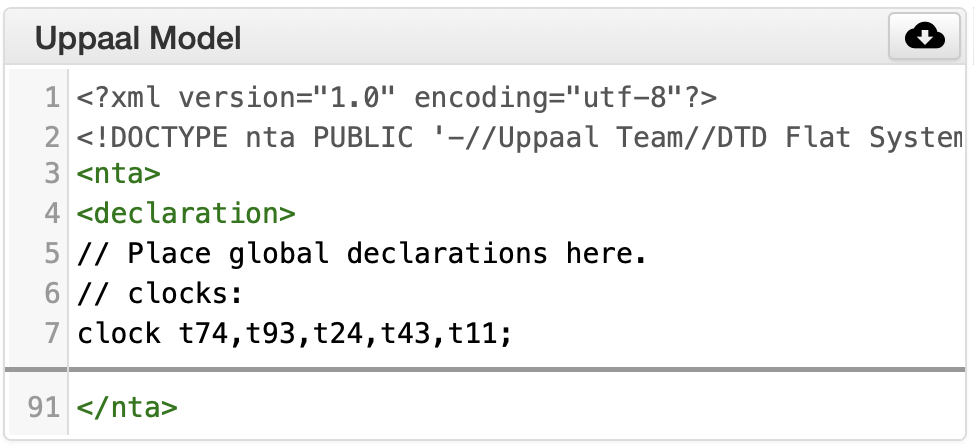Using the tools¶
Server vs Lightweight mode¶

Server (Full Hubs) vs Lightweight mode (LW Hubs)¶
While the toolset is developed in Scala, the code is compiled both into JVM binaries that are executed on a server (Full Hubs), and into JavaScript using ScalaJS to produce an interactive web page (LW Hubs).
Both versions provide almost the same functionality, with the server additionally supporting the live verification of properties through the Uppaal model checker. Everything else apart from the live verification is computed by the browser using the generated JavaScript libraries.
Widgets¶
The toolset is organized in a set of widgets, each of them providing some functionality: edition, visualization, or analysis.
By clicking in a widgets’ name it is possible to open or close such a widget. By default only some widgets are open.
All widgets, except the Examples widget use the hub specified in the Hub composer to carried on with their functionality.
Below we explain each widget in detail.
Hub Composer¶

Hub composer - Example code¶
It is the editor where users can specify hubs and tasks with different interaction semantics.
Hubs are specified by composing predefined hubs. We provide the list of primitive hubs below, followed by an explanation on how to composed them.
Tasks are defined as a sequence of input or output ports, each of which can connect to the environment following the sequence order, and using a specified interaction semantics. This is explained below in further detail.
Load the hub
Whenever a hub is specified, it is required to load the hub so that other widgets can analysed or visualised such a hub.
The hub can be loaded either by pressing shift + enter in the Hub Composer, or
by clicking in the update icon on the top right of the widget.
Primitive Hubs¶
Usage of predefined hubs is illustrated in the following tables. They are separated into original hubs in VirtusoNext™ and newly proposed hubs.
Original Hubs from VirtuosoNext™
Hub |
Usage |
|---|---|
|
|
|
|
|
|
|
|
|
|
|
|
|
|
Newly proposed hubs
Hub |
Usage |
|---|---|
|
|
|
|
|
|
|
|
|
|
|
|
|
|
|
|
|
|
Tasks¶
We can model tasks by using a predefined construct defined by the following grammar:
A task tries to communicate with the environment through its IO ports in the order established by the declaration and following the specified interaction semantics.
These interaction semantics determine how a task waits on a request to succeed. These can be:
waiting (W) – a task waits indefinitely until the request can be served
non-waiting (NW) – either the requests is served without delay or the request fails
waiting with time-out (WT) – waits either until the request is served or the specified time-out has expired.
Examples¶
The following code specifies a task named T1,
with an input port a and an output port b.
task<T1>(W a?, 4 b!)
T1 first tries to read from the environment on port a waiting until it succeeds (W).
When it succeeds, it tries to send data through b, but it waits only 4 units of time, after this time
whether it succeeds, it starts again, trying to read in a.
This semantics is given by the following THA.

T1 semantics¶
Similarly, the following code specifies a task named T2,
with an output port c.
The task periodically tries to send data through c every 5 units of time.
task<T2>(NW c!) every 5
Informally, the tasks tries to send data through c without waiting (NW).
Whether it succeeds, it will wait 5 units of time before starting again and trying to send data again.
Formally, this semantics is given by the following THA.

T2 semantics¶
Composition¶
Preo syntax¶
Composition using the Preo syntax is defined in a pointfree style, i.e., without naming the ports.
For example, the dupl(in,out1,out2) hub, is specified simply as dupl,
and the timer<n>(in,out) is specified as timer(n) or just timer for default values.
Composition of hubs and tasks can be sequential ; (outputs to inputs)
or parallel * (appending inputs and outputs).
A type system guarantees that composition is correct.
The sequential composition requires that the number of outputs match the number of inputs in the sequence.
dupl ; fifo * event
This code specifies a duplicator hub
where the first output connects to the input of a fifo hub,
and the second output connects to the input of an event hub.
More complex examples are available in the Examples widget online.
Preo syntax is extended as well with integers and booleans expression that can simplify the definition of complex hubs.
hub
^n: n hubs of type hub, n a positive integerhub
!: as many hub such that their inputs and outputs connect correctly with another hubs that may connect in sequence with hub
// for fifo hubs in parallel, composed in sequence with as many merger hubs needed (2 in this case).
fifo^4 ; merger!
Note
Checkout Typed Connector Families and Their Semantics to read the theory behind Preo.
Treo syntax¶
In the Treo syntax hubs are specified by explicitly naming their port.
Furthermore, a new hub needs to be declare in a function like manner, by specifying their ports as parameters
and declaring whether each parameter is an input port ? or an output port !.
Composition is specified by declaring two hubs separeted with spaces. Composed hubs with shared port names will synchronize over such ports.
// Main block (Preo Syntax)
// uses the hub myDupl specified in the code block
myDupl
{
// a hub using Treo syntax
myDupl(in?,out1!,out2!) =
dupl(in,o1,o2)
fifo(o1,out1)
event(o2,out2)
,
// an equivalent hub to myDupl, declared using Preo syntax
otherDupl = dupl ; fifo * event
}
More complex examples are available in the Examples widget online.
Specifying Hubs¶
The main Hub is specified following the Preo syntax.
It is possible to declare various hubs, using the Preo syntax or Treo syntax,
by declaring them in a function like manner inside a block { } and referencing their names.
Various hubs specified inside the block are separated by ,.
// Main block (Preo Syntax)
// uses the hub myDupl specified in the code block
timer(5) ; myDupl
{
// a hub using Treo syntax
myDupl(in?,out1!,out2!) =
dupl(in,o1,o2)
fifo(o1,out1)
event(o2,out2)
,
// an equivalent hub to myDupl, declared using Preo syntax
otherDupl = dupl ; fifo * event
,
// yet another hub equivalent to myDupl
yetAnotherDupl(i?, o1!, o2!) = otherDupl(i,o1,o2)
}
Circuit of the instance¶

Hub circuit - Two task, t1 and t2, write in sequence to another task act¶
This widget shows the architectural view of the hub specified in the Hub Composer, i.e. how primitive hubs and tasks are connected to form a more complex hub.
Blue boxes with names represent tasks; white circles, if any, represent free input/output ports, i.e. ports that haven’t been connected yet; and the rest of the nodes represent primitive hubs.
Arrows represent connections from output to input ports.
Incoming and outgoing arrows from tasks are labeled with the corresponding interaction semantics
(W, NW, n - n a positive integer), the port’s name (only when using the Treo syntax), and
the type of port (input or output).
Hub Automaton of the instance¶

(Timed) Hub Automaton - Example automaton for a hub timer(5)¶
This widget shows the simplified and serialized automaton of the hub specified in the Hub Composer.
A white circled location represents the initial state. All locations have a clock invariant, represented by a purple label next to the location node, e.g. \(cl\leq 5\) (right location). Locations that do not show any clock invariant are locations with trivially satisfied invariants, namely \(\top\).
Transitions are labeled as followed:
guard constraint, represented by a green label within angle brackets, e.g. \(\langle \top \rangle\)
clock constraint, if any, represented by a yellow label following the guard constraint, e.g. \(cl == 5\) (bottom transition)
synchronizing ports, represented by blue labels, e.g. \(in\downarrow\), where \(\downarrow\) represents an input port, and \(\uparrow\) an output port
updates, if any, represented by a dark blue label, e.g. \(bf:=in\) (top transition)
clock updates, if any, represented by a purple label, e.g. \(cl:=0\) (top transition)
Warning
There is a known issue where labels of the automaton are not visualised in the current version of Firefox.
Examples¶

Examples - A set of example hubs written in Preo and Treo syntax¶
This widget provides a set of example hubs, from primitive (e.g. Port and Port - 2 sources) to more complex ones (e.g. Alternator and Sequencer).
Some examples are written in Preo syntax, such as Alternator (no variables), and others in Treo syntax, such as Alternator.
By clicking on one of the examples, the corresponding code will be loaded in the Hub Composer and it will trigger the update of other widgets that are opened.
Context Switch Analysis¶

Context Switch Analysis - Minimum number of context switches for the trace p1,p2 from the hub example from Circuit of the instance¶
This widget is an interactive panel to estimate the minimum number of context switches that a given trace in the current hub will have if implemented in VirtuosoNext™.
A trace is a sequence of ports executions. In the example, the trace p1,p2 captures any trace in which p1 executes,
followed by the execution of port p2. In bot cases, p1 and p2 could execute synchronously with other ports.
It is possible to express n -sequential executions of the same port p as p^n.
For example p^3, instead of p,p,p.
The trace can be specified in the text box next to the Pattern:.
After which, it is required to load the trace by
either pressing shift + enter or clicking on the load icon on the top right of the box.
The widget will present the analysis below by stating the minimum number of context switches required, showing the transitions that follow such a trace and the number of context switches per transition.
In the example, the trace p1,p2 requires in the best case 12 CS.
Starting from the initial state 1 it transitions to state 2
by executing synchronously ports s2, get, and p1.
Context switches occur when the execution changes from the Kernel to some user task and vice-versa.
Hubs execute in the Kernel task.
The following table summarises the possible sequence of CS between the Kernel task (executing the hub) and the user
tasks responsible for the synchronisation requests on ports s2, s1, get, p1, and p2.
Each line represents 1 CS.
Notice that this is just an example. In reality, the order in which the kernel selects which task to execute next depends on many factors, including the priority of the tasks, and other tasks that might be executing.
# |
Control From |
Synchronisation Request |
Control To |
|---|---|---|---|
1 |
Kernel |
Task with s2 |
|
2 |
Task with s2 |
s2 |
Kernel |
3 |
Kernel |
Task with get |
|
4 |
Task with get |
get |
Kernel |
5 |
Kernel |
Task with p1 |
|
6 |
Task with p1 |
p1 |
Kernel |
7 |
Kernel |
Task with s1 |
|
8 |
Task with s1 |
s1 |
Kernel |
9 |
Kernel |
Task with get |
|
10 |
Task with get |
get |
Kernel |
11 |
Kernel |
Task with p2 |
|
12 |
Task with p2 |
p2 |
Kernel |
For example, assuming the execution starts in the Kernel and there are not other tasks executing apart from the ones mentioned.
The Kernel selects the next task to execute (based on priority, etc.), in this case, the task responsible for s2,
and it takes 1 CS to change control to the such a task.
This task then request to synchronise on port s2 and the control goes back to the kernel (+1 CS).
Please notice that this widget is experimental.
Hub Automaton Analysis¶

THA Analysis - example of structural properties for the automaton of the hub specified in the Hub Composer¶
This widget provides a summary of some structural properties of the timed hub automaton. Currently:
Memory estimation - minimum memory size (bits) required in terms of data (assumes Integer variables) and clock variables (Float variables), and in terms space needed to encode all states. Typically \(\lceil\log_2(n)\rceil\) bits are required to encode n states.
Code size estimation - lines of code needed to encode the hub. Typically one line per: transition, state, variable, guard, and assignment instruction. We consider assignment instruction to clock resets and assignments on internal variables. Assignments from input to output ports are not consider as such.
Always available ports - information about which ports of the hub are always ready to synchronise (up to some restrictions). This is, ports that are ready to execute in any state of the hub, possibly up to some restrictions imposed by guards, or synchronizations with other ports. For example in a data
dataEventhub, the input port is always ready to synchronize without delay, and without restrictions imposed by the hub - transitions with this port are single-action transitions and have a trivially satisfied guard.
Temporal Logic¶

Temporal Logic - example of temporal properties for the automaton of the hub specified in the Hub Composer¶
This widget is the editor where the user can specify a list of timed behavioral properties, and (if using the server version) verify them by relying on an instance of the Uppaal model checker running in our server (if using ArcaTools) or the user’s computer (if using a local installation).
The grammar¶
Properties are given using a dynamic temporal logic proposed for Timed Hub Automata, which can be seen as a subset of Uppaal Timed Computation Tree Logic (TCTL). This logic provides new operators to reason about the behaviour of the systems focusing on actions, i.e., on ports that are fired rather than on locations as Uppaal TCTL.
TCTL properties are described using path formulas and state formulas. A path formula quantifies over paths of the underlying transition system, while a state formula quantifies over a single state of such system.
A valid property consists of a path formula pf given by the following grammar
// path formula
pf ::= A[] sf | E[] sf | A<> sf | E<> sf | sf --> sf | every a --> b [after n]
// state formula
sf ::= a | a.doing | a.done
| a refiresAfter n | a refiresAfterOrAt n | a refiresBefore n | a refiresBeforeOrAt n |
| not sf
| sf and sf | sf imply sf | sf or sf
| ecc
| deadlock | nothing
// extended clock constraints
ecc ::= c # n | c - # n | ecc and ecc | a.t # n
// clock constraints operators
# :: = < | <= | == | >= | >
where a and b are port names, c is a clock, and n is an Integer.
A and E are the universal and existential quantifiers over paths,
while [] and <> are the universal and existential quantifiers over states.
a.t is a special clock assigned to port a that is set to 0 every time a fires – i.e.,
after a fired, this clock tracks the time since a last fired.
The following table describes intuitively when each formula is satisfied.
Construct |
Description |
|---|---|
|
Holds if in all possible paths,
|
|
Holds if in all possible paths,
|
|
Holds if in at least one path,
|
|
Holds if in at least one path,
|
|
Holds if whenever in every path where |
|
Holds if, whenever a fires, b will fire before a fires again, but after 5 or more units of time since a fired. |
|
Holds at the time instance when port a fires. |
|
Holds if a was the last port to be fired. |
|
Holds if a has fired at least once. |
|
Holds in states where, if a fired, then it cannot refire until more than n units of time passed. |
|
Holds in states where, if a fired, then it cannot refire until n or more units of time passed. |
|
Holds in states where a fires before less than n units of time passed since the beginning or since it last fired. |
|
Holds in states where a fires before n or less units of time passed since the beginning or since it last fired. |
|
Holds in states where sf is not satisfied |
|
Holds in states where both |
|
Holds in states where |
|
Holds in states where if |
|
Holds in states where no action has fired previously. |
|
Holds in states where there are no outgoing action transitions neither from the state itself or any of its delay successors. |
|
Holds in states where the current value of clock c, \(\eta(c)\), satisfies the condition \(\eta(c) ~\#~ n\). |
|
Holds in states where the current value of clock c1 and c2, satisfy the condition \(\eta(c1) - \eta(c2) ~\#~ n\). |
|
Holds in states where both clock constraints |
|
Holds in states where the current value of clock |
The widget¶
To analyse the properties the user needs to load the properties
by either pressing shift + enter or by clicking on the load icon on the top right of the widget.
Even when using the lightweight version, the widget provides the necessary information to verify each property using Uppaal manually.
After loading the properties, a new box appears showing the results. In particular, for each property, the result box shows:
whether it is satisfied (✓ or ✗). This is shown only when using the server version (Full Hubs)
its encoding using Uppaal’s temporal logic syntax. This is accessed by clicking on the expand button
. Notice that a property using our logic might be translated into several Uppaal properties. In this case, we show for each Uppaal property whether it is satisfied - all should be satisfied in order to satisfy the original property.
the Uppaal model needed to verify such a property and the property itself encoded using Uppaals’ syntax. This can be downloaded by clicking on
.

Verification Information - Output result from loading the properties in the Temporal Logic box.¶
One Uppaal model per property
Depending on the kind of property, the model may need to incorporate more or less auxiliary variables in order to support such a query. For example, a.done query requires to add a Boolean variable a_done to the model, initialized as false and set to true whenever port a fires (never set to false again). Thus, each property has its own Uppaal model.
Manual verification using Uppaal¶
Although the user can automatically verify properties from the temporal logic widget, as explained above,
it its possible to download the model and import the model from the Uppaal model checker.
After running Uppaal, go to File -> Open System and select the .xml model downloaded either from the
Uppaal Model or Temporal Logic widget.
Editor: shows the automaton of the hub and the structure of the Uppaal Project. Global declarations of variables, clocks, and channels, can be found under Declarations, while local declarations can be found under Hub -> Declarations. The initialization of the system is found under System declarations.
Simulator: provides tools to simulate executions by selecting an enabled transition, while highlighting the current location in the automaton, among other functionality.
Verifier: provides functionality to write temporal properties and verify them. If the model imported was downloaded from the Temporal Logic widget, it will show the corresponding property for which the model was created.
Uppaal Model¶

Uppaal Model - Uppaal timed automaton model of the hub specified in the Hub Composer.¶
This widget provides the base Uppaal timed automaton model of the hub specified in the Hub Composer. By base we mean that the model does not have any auxiliary variable or committed states in between states of the original model, as is the case with Uppaal models generated in the Temporal Logic widget.
The model can be downloaded and imported into the Uppaal model checker for further analysis.